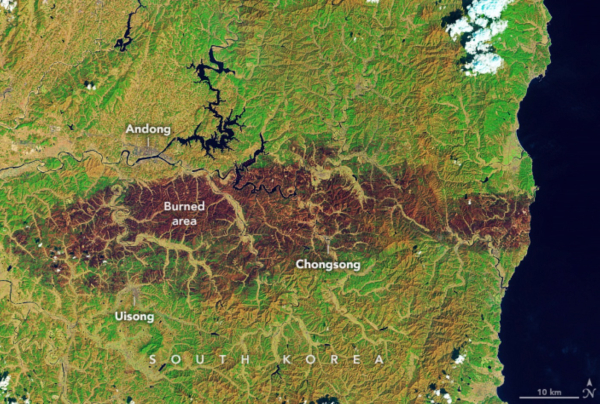
In late March, wildfires ripped through the Southeast region of South Korea.
Known as the Uiseong wildfires, they are one of the worst wildfires in South Korea’s history. Initially beginning in Uiseong on March 22, they spread rapidly across Gyeongsangbuk-do. The fires traveled through multiple cities and villages, with the estimated burned ground equal to approximately 80% of the area of Seoul. Complete evacuation orders have been assigned to Andong, Cheongsong, and Yeongdeok, while partial evacuation orders have been assigned to Uiseong, Yecheon, Yeongyang, Uljin, and Pohang.
The blaze impacted an area of over 48,000 hectares (119,000 acres), more than the total area burned by wildfires between 2015 and 2024. That is about double the size of the Los Angeles fires, which affected an area of around 23,300 hectares (57,600 acres). A 1300-year-old temple, Goeunsa, has been entirely burnt down. Strong winds, dense pine trees, and dry weather further fueled the fire. Villages and cultural heritage sites have been reduced to ash and rubble.
At least 28 people have died. When counting the injured as well, the number grows to 83. South Korea is a rapidly aging country, and Gyeongsangbuk-do is the second-oldest province. Most of the people residing in the affected areas were above 65. Mobility issues and the struggle to read emergency alerts made it difficult for the elderly to evacuate, resulting in such a high death toll. The estimated count of displaced people is around 37,800. Water, electricity, and necessities such as food and clothing are becoming a huge problem.
A month has passed since the fires, but the damage is lasting. People lost their homes, their neighbours, and their families. Recovery will be prolonged, with the affected areas requiring infrastructural repair, ecosystem restoration, and community healing. The government is assigning temporary accommodation and providing 300,000 KRW to the affected, but people are struggling.
The Korean Red Cross accepts donations through 301-0171-0424-51 (Nonghyup Bank, Korean Red Cross). You can also donate through the Korean Red Cross website, along with Wegive and Naver HappyBean. No matter how small, all donations will help the community heal.


